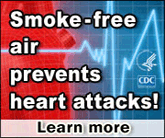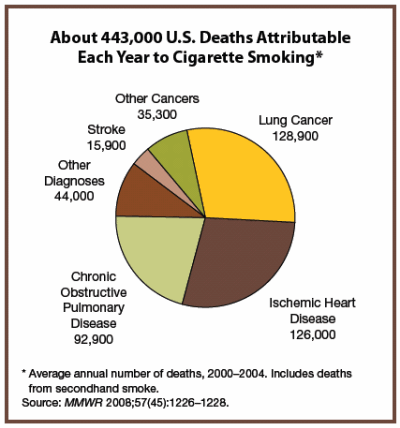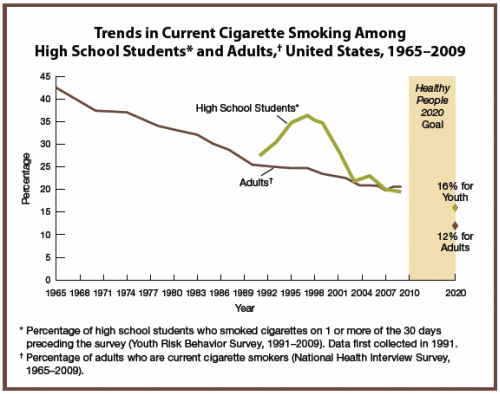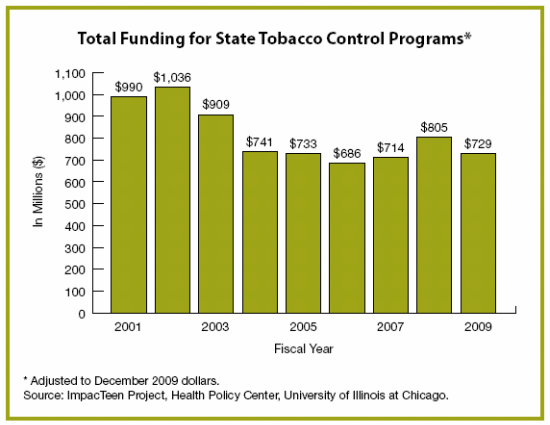Tobacco Use
Targeting the Nation’s Leading Killer
At A Glance 2011
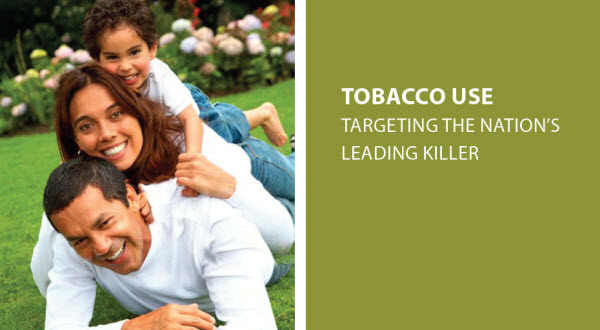
On this Page
The Burden of Tobacco Use
Tobacco use is the single most preventable cause of disease, disability, and death in the United States. Each year, an estimated 443,000 people die prematurely from smoking or exposure to secondhand smoke, and another 8.6 million live with a serious illness caused by smoking. Despite these risks, approximately 46.6 million U.S. adults smoke cigarettes. Smokeless tobacco, cigars, and pipes also have deadly consequences, including lung, larynx, esophageal, and oral cancers.
The harmful effects of smoking do not end with the smoker. An estimated 88 million nonsmoking Americans, including 54% of children aged 3–11 years, are exposed to secondhand smoke. Even brief exposure can be dangerous because nonsmokers inhale many of the same poisons in cigarette smoke as smokers.
Secondhand smoke exposure causes serious disease and death, including heart disease and lung cancer in nonsmoking adults and sudden infant death syndrome, acute respiratory infections, ear problems, and more frequent and severe asthma attacks in children. Each year, primarily because of exposure to secondhand smoke, an estimated 3,000 nonsmoking Americans die of lung cancer, more than 46,000 die of heart disease, and about 150,000–300,000 children younger than 18 months have lower respiratory tract infections.
Coupled with this enormous health toll is the significant economic burden of tobacco use—more than $96 billion a year in medical costs and another $97 billion a year from lost productivity.
The Tobacco Use Epidemic Can Be Stopped
The Institute of Medicine (IOM) report, Ending the Tobacco Problem: A Blueprint for the Nation, presents a plan to "reduce smoking so substantially that it is no longer a public health problem for our nation." Foremost among the IOM recommendations is that each state should fund a comprehensive tobacco control program at the level recommended by CDC in Best Practices for Comprehensive Tobacco Control Programs–2007. This publication is a guide to help states plan and establish effective tobacco control programs to prevent and reduce tobacco use.
Evidence-based, statewide tobacco control programs that are comprehensive, sustained, and accountable have been shown to reduce smoking rates, tobacco-related deaths, and diseases caused by smoking. A comprehensive program is a coordinated effort to establish smoke-free policies, reduce the social acceptability of tobacco use, promote cessation, help tobacco users quit, and prevent initiation of tobacco use. This approach combines educational, clinical, regulatory, economic, and social strategies.
Research has documented the effectiveness of laws and policies to protect the public from secondhand smoke exposure, promote cessation, and prevent initiation by young people. For example, states can
-
Increase the unit price of tobacco products.
-
Implement smoke-free policies, regulations, and laws.
-
Provide insurance coverage of tobacco-use treatment.
-
Limit minors' access to tobacco products.
CDC's Response
CDC is the lead federal agency for comprehensive tobacco control. CDC's Office on Smoking and Health provides national leadership for a broad-based approach to reducing tobacco use. A variety of government agencies, professional and voluntary organizations, and academic institutions have joined together to advance this approach, which involves
-
Preventing young people from starting to smoke.
-
Eliminating exposure to secondhand smoke.
-
Promoting quitting among young people and adults.
-
Identifying and eliminating tobacco-related health disparities among different population groups.
Essential elements of this comprehensive approach include interventions at state, community, and health system levels; cessation services; countermarketing; policy development and implementation; surveillance; and evaluation.
CDC also promotes MPOWER, a package of six proven strategies identified by the World Health Organization that can help reduce tobacco use and tobacco-related illness and death.
Monitor tobacco use and prevention policies.
Protect people from tobacco smoke.
Offer help to quit tobacco use.
Warn about the dangers of tobacco.
Enforce bans on tobacco advertising, promotion, and sponsorship.
Raise taxes on tobacco.
Sustaining State Programs
CDC continues to support comprehensive programs to prevent and control tobacco use in all 50 states, the District of Columbia, 8 U.S. territories/jurisdictions, and 8 tribal support centers. In addition, CDC funds 6 national networks to reduce tobacco use among specific populations, as well as 22 state education agencies and 1 tribal government for coordinated school health programs to help prevent tobacco use.
CDC also publishes and disseminates best practices to help states plan, implement, evaluate, and sustain their own tobacco control programs. The agency provides technical assistance and training for these efforts.
Expanding the Science Base
CDC is responsible for conducting and coordinating research, surveillance, laboratory, and evaluation activities related to tobacco and its effect on health. For example, CDC
-
Monitors tobacco use, related behaviors, and tobacco control programs and policies.
-
Conducts process, outcome, and impact evaluations of comprehensive tobacco control programs and policies.
-
Publishes reports, manuals, papers, and surveillance material to answer important questions about tobacco control.
-
Provides technical assistance to states for the Adult Tobacco Survey, Youth Tobacco Survey, and other survey systems.
-
Provides technical assistance to countries that use the Global Tobacco Surveillance System, which includes school-based and household-based surveys.
-
Evaluates additives and chemical constituents of tobacco and tobacco smoke.
Communicating Information to the Public
CDC translates research into practice by keeping the public, policy makers, health professionals, and partners informed about current developments and initiatives in tobacco control.
-
In Fiscal Year 2010, nearly 6 million people visited CDC's Smoking & Tobacco Use Web site. CDC responded to about 15,000 tobacco-related inquiries and distributed nearly 320,000 publications and video products.
-
CDC works with other federal, state, and local agencies to provide materials and resources to educators, employers, public health workers, the media, and other community leaders who are working to prevent tobacco use.
-
Through the Media Campaign Resource Center and the Cessation Resource Center, CDC helps states stretch their media budgets by using and adapting existing ads and other materials rather than creating new ones.
Promoting Action Through Partnerships
CDC works with national and international partners to ensure that diverse groups are involved in tobacco control efforts.
-
CDC manages the U.S. Department of Health and Human Services' (HHS) Interagency Committee on Smoking and Health, which coordinates research programs among federal, state, local, and private agencies.
-
CDC coordinates and promotes tobacco prevention and control activities with partners, including the American Cancer Society, American Heart Association, Americans for Nonsmokers' Rights, Legacy, American Lung Association, Campaign for Tobacco-Free Kids, National Cancer Institute, Robert Wood Johnson Foundation, Substance Abuse and Mental Health Services Administration, Tobacco Technical Assistance Consortium, U.S. Environmental Protection Agency, U.S. Food and Drug Administration (FDA), World Bank, and several national networks.
-
CDC, in partnership with the National Cancer Institute, the North American Quitline Consortium, and state tobacco control programs, has developed the National Network of Tobacco Cessation Quitlines. By calling 1-800-QUIT NOW, callers from across the nation have free and easy access to tobacco cessation services in their state.
-
CDC helped develop Ending the Tobacco Epidemic: A Tobacco Control Strategic Action Plan for the U.S. Department of Health and Human Services. This plan outlines a comprehensive approach for mobilizing resources across HHS to support proven, pragmatic, achievable interventions that can be implemented at federal, state, and community levels.
Future Directions
CDC will continue to work with policy makers, health officials, partners, and the public to ensure that tobacco control remains a key element of public health domestically and globally. Agency priorities include the following:
-
Advancing smoke-free policies, price increases, and mass media education.
-
Helping states increase their resources for comprehensive tobacco control programs.
-
Expanding access to cessation services to help tobacco users quit (e.g., by expanding the reach of quitlines and coverage by Medicaid, Medicare, and private insurance).
-
Supporting FDA regulation of tobacco products.
-
Improving surveillance in the United States and globally.
Success Stories
Smoke-Free Laws Reduce Exposure and Improve Health
Each year in the United States, an estimated 3,000 lung cancer deaths and 46,000 heart disease deaths are attributed to exposure to secondhand smoke. According to the 2006 U.S. Surgeon General's report The Health Consequences of Involuntary Exposure to Tobacco Smoke, there is no risk-free level of exposure to secondhand smoke. Both the Surgeon General and the Institute of Medicine (IOM) have concluded that eliminating smoking from all indoor areas is the only way to fully protect people from exposure.
Policies that prohibit smoking in all indoor areas
-
Eliminate secondhand smoke exposure.
-
Improve indoor air quality.
-
Reduce negative health outcomes among nonsmokers.
-
Decrease cigarette consumption.
-
Encourage smokers to quit.
-
Change social norms regarding the acceptability of smoking.
In terms of specific health risks, the 2009 IOM report Secondhand Smoke Exposure and Cardiovascular Effects: Making Sense of the Evidence concluded that
-
Secondhand smoke exposure can cause a heart attack.
-
Even brief exposure to secondhand smoke could plausibly trigger a heart attack.
-
Smoke-free policies result in fewer heart attacks.
Current evidence from more than a dozen studies in cities, states, and countries indicates that smoke-free policies yield immediate cardiovascular benefits. Jurisdictions that have implemented smoke-free policies have reported average reductions in heart attack hospitalizations of 8% to 17%. In 2010, Kansas, Michigan, and Wisconsin passed laws that made workplaces and public places smoke-free. The new laws represent clear and measurable progress toward saving lives and protecting people in these states.
By December 2010, a total of 25 states and the District of Columbia had comprehensive smoke-free laws that prohibit smoking in workplaces, restaurants, bars, and other public places. However, 88 million nonsmoking Americans are still exposed to secondhand smoke, and many areas of the country do not have smoke-free laws.
Populations disproportionately affected by exposure to secondhand smoke include African Americans, children, and those working in blue collar and hospitality sectors, particularly bar and casino employees.
Smoking Cessation in Massachusetts
About 70% of the 46.6 million smokers in the United States want to quit, and more than 40% try to quit each year. The U.S. Public Health Service's Clinical Practice Guideline: Treating Tobacco Use and Dependence: 2008 Update recommends that clinicians provide every patient willing to try to quit with an effective cessation treatment. However, cessation counseling and medications are not readily available to uninsured patients and patients whose health plans omit or restrict coverage.
In 2007, CDC released the updated Best Practices for Comprehensive Tobacco Control Programs—2007, which recommends that states promote quitting among adults and young people. CDC also provides funding to help states promote cessation programs and evaluate their efforts.
For example, CDC helped promote and evaluate a smoking cessation intervention in Massachusetts that led to a sharp reduction in smoking rates among Medicaid beneficiaries. The state expanded Medicaid benefits to include coverage of up to 16 individual or group counseling sessions and two 90-day supplies a year of cessation medications approved by the U.S. Food and Drug Administration. Eligible participants could receive these benefits for copayments of $1–$3.
To promote the intervention, state health officials worked with community and professional groups to distribute educational materials and make presentations to health care providers. They also mailed materials to residents across the state, distributed posters through local groups, and ran advertisements in print, radio, and transit markets.
An evaluation of the intervention found that about 37% of all Medicaid beneficiaries who were smokers (70,140 people) used these benefits. During the first 18 months, smoking rates among Medicaid beneficiaries in Massachusetts declined by 26%. During the same period, hospital admissions for acute myocardial infarction decreased by 46% for this population group. Admissions for other acute coronary heart disease diagnoses decreased by 49%.
The Price of Cigarettes Across the Nation
Raising the price of tobacco has proven to be one of the most effective strategies for preventing and controlling tobacco use. Specifically, the Surgeon General has concluded that increasing cigarette prices would decrease the prevalence of tobacco use, particularly among youth and young adults, and that increases in cigarette excise taxes would lead to substantial long-term improvements in the nation's health. A 10% increase in the price of cigarettes is estimated to reduce consumption by nearly 4% among adults, and the potential reduction among young people and low-income populations is even higher.
In 2009 and 2010, a total of 20 states, the District of Columbia, and the federal government increased excise tax rates for cigarettes. During this period, the combined federal and average state cigarette excise tax increased from $1.57 to $2.45 a pack.
Notably, South Carolina, which previously had the nation's lowest cigarette excise tax, raised its tax in 2010 for the first time in 33 years—by 50 cents to $0.57 a pack. The state also allocated $5 million toward smoking prevention and cessation efforts. In addition, the U.S. territory of Guam increased its cigarette excise tax by 200%, raising the price of cigarettes on the island from $1 to $3 a pack.
As of December 2010, the following five states had set excise tax rates of $3 or more per pack: New York ($4.35), Rhode Island ($3.46), Washington ($3.025), Connecticut ($3), and Hawaii ($3). According to estimates from the Campaign for Tobacco-Free Kids, a $1 increase in the price of a pack of cigarettes in all states would reduce smoking-related disease and death and result in more than $52 billion in long-term health savings over 5 years.
For more information, please contact the Centers for Disease Control and Prevention
National Center for Chronic Disease Prevention and Health Promotion
4770 Buford Highway NE, Mail Stop K-50, Atlanta, GA 30341-3717
Telephone: 800-CDC-INFO (232-4636) • TTY: 888-232-6348
E-mail: cdcinfo@cdc.gov • Web:
http://www.cdc.gov/tobacco
Contact Us:
- Centers for Disease Control and Prevention
National Center for Chronic Disease Prevention and Health Promotion (NCCDPHP)
4770 Buford Hwy, NE
MS K-40
Atlanta, GA 30341-3717 - 800-CDC-INFO
(800-232-4636)
TTY: (888) 232-6348
8am-8pm ET
Monday-Friday
Closed Holidays - Contact NCCDPHP

